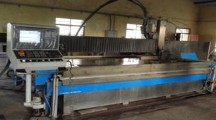Abstract
The better machining capabilities of abrasive waterjet cutting (AWJC) characterized by the absence of thermal distortion make it highly competitive with other cutting processes employing plasma and lasers. The present report was oriented towards examining the effect of AWJC parameters like abrasive grain size, abrasive flow rate, nozzle–workpiece standoff, water pressure and jet traverse rate on the surface roughness and taper angle of cut produced with ceramic tiles. Taguchi’s L27 orthogonal array was used for conducting the cutting trials, and a combined technique of grey-based response surface methodology (g-RSM) was disclosed for obtaining the optimal level of AWJC parameters. The g-RSM method was supplemented with analysis of variance to identify the vital parameters affecting the quality characteristics. The optimal parameter setting was validated by conducting a confirmation test. The cut surfaces were also examined using field emission scanning electron microscope images, P-profile plots and atomic force microscope images.
Similar content being viewed by others
References
Khan A.A., Haque M.M.: Performance of different abrasive materials during abrasive water jet machining of glass. J. Mater. Proc. Technol. 191(1-3), 404–407 (2007)
Akkurt A., Kulekci M.K., Seker U., Ercan F.: Effect of feed rate on surface roughness in abrasive waterjet cutting applications. J. Mater. Proc. Technol. 147(3), 389–396 (2004)
Ma C., Deam R.T.: A correlation for predicting the kerf profile from abrasive water jet cutting. Exp. Therm. Fluid. Sci. 30(4), 337–343 (2006)
Mahabalesh P.: A study of taper angles and material removal rates of drilled holes in the abrasive water jet machining process. J. Mater. Proc. Technol. 189(1-3), 292–295 (2007)
Azmir M.A., Ahsan A.K., Rahmah A.: Effect of abrasive water jet machining parameters on aramid fibre reinforced plastics composite. Int. J. Mater. Form. 2(1), 37–44 (2009)
Ay M., Caydas U., Hascalik A.: Effect of traverse speed on abrasive waterjet machining of age hardened Inconel 718 nickel-based super alloy. Mater. Manuf. Process. 25(10), 1160–1165 (2010)
Cosansu C., Cogun C.: An investigation on use of colemanite powder as abrasive in abrasive waterjet cutting (AWJC). J. Mech. Sci. Technol. 26(8), 2371–2380 (2012)
Krishnaiah K., Shahabudeen P., Jeyapaul R.: Quality management research by considering multi-response problems in the Taguchi method—a review. Int. J. Adv. Manuf. Technol. 26(11-12), 1331–1337 (2005)
Adnan M.R.H., Sarkheyli A., Zain A.M., Haron H.: Fuzzy logic for modeling machining process: a review. Artif. Intell. Rev. 43(3), 345–379 (2013)
Canakci A., Ozsahin S., Varol T.: Prediction of Effect of Reinforcement Size and Volume Fraction on the Abrasive Wear Behavior of AA2014/B4Cp MMCs Using Artificial Neural Network. Arab. J. Sci. Eng. 39(8), 6351–6361 (2013)
Kechagias J., Petropoulos G., Vaxevanidis N.: Application of Taguchi design for quality characterization abrasive water jet machining of TRIP sheet steels. Int. J. Adv. Manuf. Technol. 62(5-8), 635–643 (2012)
Karthikeyan R., Adalarasan R., Pai B.C.: Optimization of Machining Characteristics for Al/SiCp Composites using ANN/GA. J. Mater. Sci. Technol. 18(1), 47–50 (2002)
Zohoor M., Nourian H.: Development of an algorithm for optimum control process to compensate the nozzle wear effect in cutting the hard and tough material using abrasive water jet cutting process. Int. J. Adv. Manuf. Technol. 61(9-12), 1019–1028 (2012)
Adalarasan R., Santhanakumar M., Shanmugasundaram A.: Optimization of weld characteristics of friction welded AA 6061-AA 6351 joints using grey-principal component analysis (G-PCA). J. Mech. Sci. Technol. 28(1), 301–307 (2014)
Gopalakannan S., Senthilvelan T.: Modeling and application of response surface method on machining of Al–SiC nano-composites. Measurement 46(8), 2705–2715 (2013)
Adalarasan R., Santhanakumar M., Rajmohan M.: Application of Grey Taguchi-based response surface methodology (GT-RSM) for optimizing the plasma arc cutting parameters of 304L stainless steel. Int. J. Adv. Manuf. Technol. 78(5-8), 1161–1170 (2015)
Adalarasan R., Santhanakumar M., Rajmohan M.: Optimization of laser cutting parameters for Al6061/SiCp/Al2O3 composite using grey based response surface methodology (GRSM). Measurement 73, 596–606 (2015)
Aggarwal V., Khangura S.S., Garg R.K.: Parametric modeling and optimization for wire electrical discharge machining of Inconel 718 using response surface methodology. Int. J. Adv. Manuf. Technol. 79(1-4), 31–47 (2015)
Yue Z., Huang C., Zhu H., Wang J., Yao P., Liu Z.W.: Optimization of machining parameters in the abrasive waterjet turning of alumina ceramic based on the response surface methodology. Int. J. Adv. Manuf. Technol. 71(9-12), 2107–2114 (2014)
Garg S.K., Manna A., Jain A.: An Investigation on Machinability of Al/10 % ZrO2(P)-Metal Matrix Composite by WEDM and Parametric Optimization Using Desirability Function Approach. Arab. J. Sci. Eng. 39(4), 3251–3270 (2014)
Subramanian M., Sakthivel M., Sudhakaran R.: Modeling and Analysis of Surface Roughness of AL7075-T6 in End Milling Process Using Response Surface Methodology. Arab. J. Sci. Eng. 39(10), 7299–7313 (2014)
Author information
Authors and Affiliations
Corresponding author
Rights and permissions
About this article
Cite this article
Santhanakumar, M., Adalarasan, R. & Rajmohan, M. Experimental Modelling and Analysis in Abrasive Waterjet Cutting of Ceramic Tiles Using Grey-Based Response Surface Methodology. Arab J Sci Eng 40, 3299–3311 (2015). https://doi.org/10.1007/s13369-015-1775-x
Received:
Accepted:
Published:
Issue Date:
DOI: https://doi.org/10.1007/s13369-015-1775-x




